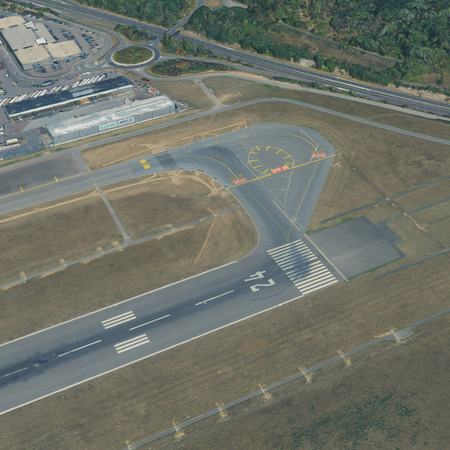
EASA Aerodrome Certification+Runway re-design
Airport: Luxembourg Airport, Luxembourg (EU).
Client: Administration de la navigation aérienne (ANA).
The European Aviation Safety Agency had begun mandating European airports to undergo Certification, to achieve standardization in aerodrome infrastructure and procedures, and thereby enhance safety for operation of aircrafts.
Luxembourg Airport (ELLX, LUX) has been operating RWY 06-24 - a CAT IIIb, 60m wide, full strength pavement runway. Historically, it has been serving a mix of cargo, passenger, and military traffic. The runway has been lengthened multiple times per need basis. The runway dates back several decades and after all these years of serving, is deteriorating and needs a full rebuild.
As certification is based on the largest facility at the aerodrome, the runway, the big question was ‘Is what we have good into the future for our intended operations, or does it need to change?’.
The task was solving that question for my client. Appointed as the in-house, on-site consultant, designated as 'Aerodrome Expert' and I served as Focal-Point on this project. Initial combined cost of runway-rebuild, and its taxiway system update itself was estimated at €83million.
Unique components of the project adding to its complexity included:
· Protected, heritage buildings in the vicinity of air traffic maneuvring area.
· A project of this magnitude was a first for all the stakeholders.
· Scheduled Code D and Code F traffic.
· Unscheduled flight operations include the NATO aircrafts and the AN124.
Project management for a scope of such magnitude called foremost for establishing from senior-most leadership to ground-level personnel, the grounds-up protocols for communication, documentation, responsibility of actions, and traceability of both decisions and of actions.
An unforeseen challenge emerged that the airport’s air-traffic development related information and data would not be made available i.e. shared, as it was deemed too sensitive. Unlike most airports around the world, the organizational structure of LUX at the time of the project undertaken, was fragmented. One stakeholder operated the airport terminal, aprons and hangars. Another second stakeholder managed the maneuvring areas surfaces, and a third stakeholder, ANA, the aerodrome operator at the time, managed everything else including the air navigation. Relations between the three infrastructure were tumultuous. Other stakeholders included the Ministry, Cargolux, the local cargo carrier and Luxair, the flag carrier passenger airline.
Having no access to the planned future of the airport, the project thus called upon deep understanding of working of airports, forecasting principles, knowledge of airline operations, ability to derive from market research, and other influencing factors to determine most likely fleet-mix that could be operating to and from LUX and only then determine, what airfield configuration would best serve the current and future intended scheduled operations.
The most input I got was a verbal conformation from the CEO of the terminal operator, the people in the know of the growth and development data for the airport, that my analysis was producing right results and we, my client and I, could take the projections forward in developing updates for the airfield design.
Project outcomes :
The proposal eliminated close to €20million from project's direct cost alone i.e., nearly 25% in costs saved.
The optimized design further reduces the list of non-compliances to be pursued and therefore further reduces the cost of regulation.
Representing my client, ANA, I presented the proposed RWY 06-24 design, with Certification Code, and Certification Basis (CB) in a stakeholder’s meeting to Luxembourg’s Minister of Infrastructure and ministers from his office. Meeting included project's other stakeholders- Director Ponts and Chaussées, CEO of lux-Airport, Luxair representatives, and from ANA the Director and the Deputy Director.
Achievement:
The proposed Certification Code and Certification Basis went on to be accepted by the airport stakeholders and Minister of Infrastructure. The width of RWY06-24 at 45m is reflected in the LUX AIP. The width of the runway before certification was 60m.
Furthermore:
I provided the airport with construction phasing to achieve the transition to 45m from the 60m width, without interrupting daily operations.
Provided EASA compliant design for the RESA at end of RWY 06
Provided entry, movement, and staging plan for equipment, and materials i.e.Enabling Works for construction.
Supported the Electrical department in review of the runway lighting with focus on optimization of in-pavement elements. In the bigger scheme of events, this optimization helps reduce the time in construction of the runway.
Identified revenue generation opportunities for the aerodrome operator.
Supported Finance department with comparative evaluation of air navigation charges and thus revenues as obtained through prevailing models.
An aerodrome's certification means compliance with regulation and standardization of infrastructure and procedure. For an airline this supports business planning and development. For an aircraft, it sets expectation on the key operational facilities as it arrives. For an airport, Certification Code translates to cost of regulation, and economic opportunities, and thus the future of an airport for decades to come. Getting this right spells the difference between over-design and redundant capacity versus being on the cutting edge of design efficiency while preserving land for future development.
Being the only airport in the country of Luxembourg, this work and success of this project positively supports the economy of Luxembourg for years to come.
Images: Geoportail, ELLX AIP, personal project archives.
Project Gallery





